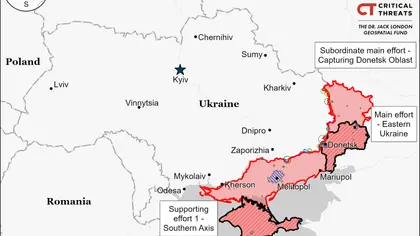Key Takeaways from the ISW:
- Ukraine used US-provided ATACMS long-range missiles to strike Russian targets in occupied Ukraine for the first time on October 17.
- The Ukrainian ATACMS strikes on operationally significant Russian airfields in Ukraine will likely prompt the Russian command to disperse aviation assets and withdraw some aircraft to airfields further from the frontline.
- The Russian military has consistently shown it can adapt to new Ukrainian strike capabilities — but only after suffering initial and pronounced losses from Ukrainian capabilities Russian commanders realistically should have prepared for.
- The arrival of ATACMS long-range missiles also presents a significant threat to Russian ammunition depots in rear areas and will likely force the Russian command to choose between fortifying existing depots or further dispersing depots throughout occupied Ukraine.
- The Russian information space expressed widespread fear over the use of ATACMS, and Russian concerns over the possibility of future strikes will likely impact Russian decision-making beyond the current Ukrainian ability to sustain regular ATACMS strikes.
- Ukrainian forces continued counteroffensive operations and advanced near Bakhmut and in western Zaporizhia Oblast.
- The Russian Ministry of Internal Affairs (MVD) reportedly issued an informal warning to a prominent Russian milblogger who is often critical of the Ministry of Defense’s conduct of the war on October 16 for discrediting the Russian military.
- Russian forces continued offensive operations along the Kupyansk-Svatove-Kreminna line, near Bakhmut, near Avdiivka, southwest of Donetsk City, in the Donetsk-Zaporizhia Oblast border area, and in western Zaporizhia Oblast, and advanced in certain areas of the front.
- Russia continues to take steps to codify the inclusion of volunteer formations within Rosgvardia.
- The Russian Orthodox Church (ROC) continues efforts to consolidate control of orthodox diocese in occupied areas of Ukraine.
- Russian President Vladimir Putin held bilateral negotiations with Hungarian President Viktor Orban and Mongolian President Ukhnaagiin Khurelsukh in Beijing on October 17.
Authors:Angelica Evans, Nicole Wolkov, Grace Mappes, Christina Harward, Kateryna Stepanenko, and Mason Clark.
See the original here.
JOIN US ON TELEGRAM
Follow our coverage of the war on the @Kyivpost_official.
To suggest a correction or clarification, write to us here
You can also highlight the text and press Ctrl + Enter
You can also highlight the text and press Ctrl + Enter












